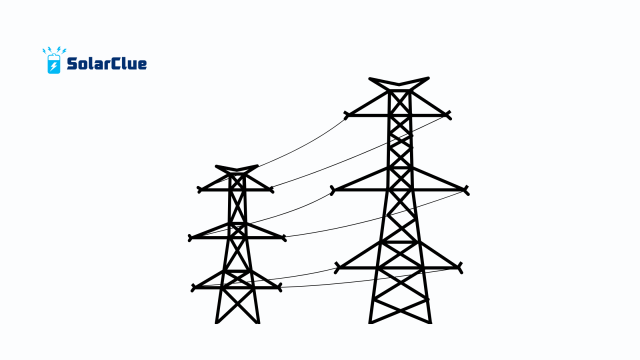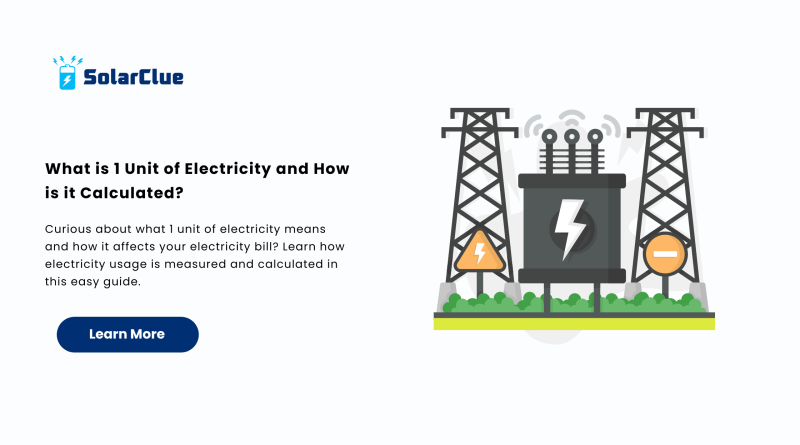What is 1 Unit of Electricity and How is it Calculated?
Understanding electricity bills can feel confusing, especially when terms like 1 unit of electricity are used without much explanation. If you’ve ever looked at your power bill and wondered what a “unit” actually means or how your monthly charges are calculated, you’re not alone. This blog is here to break it down in the simplest way possible—so you can take control of your energy usage, cut unnecessary costs, and even explore smarter alternatives like solar power. Let’s get started by understanding exactly what 1 unit of electricity is and how it’s calculated.
When you receive your electricity bill, you’ll notice it mentions the number of “units” consumed. But what exactly is 1 unit of electricity? In simple terms, 1 unit = 1 kilowatt-hour (kWh) of electricity. This means if you use a 1000-watt appliance for one hour, you have consumed 1 unit of electricity.
It’s a basic measurement used globally to calculate how much power you have used over time. Understanding this helps in managing electricity usage and reducing unnecessary costs.
Table of Contents
Why Understanding Units Matters
Knowing what 1 unit of electricity is can help you:
-
Monitor your daily electricity consumption
-
Calculate your monthly electricity bill
-
Choose energy-efficient appliances
-
Plan for solar power or other renewable options
In short, it gives you control over your energy usage and expenses.
How is 1 Unit of Electricity Calculated?
Let’s break it down:
Step 1: Know the Wattage of Your Appliance
For example, a fan might be 75 watts, while an AC may use 1500 watts (1.5 kW). The wattage is usually printed on a label attached to the appliance.
Step 2: Multiply by Usage Time (in Hours)
Let’s say you run a 1000-watt appliance for 3 hours:
1000 watts × 3 hours = 3000 watt-hours = 3 kWh
So, you’ve used 3 units of electricity.
Step 3: Convert Watts to Kilowatts
Since 1 kW = 1000 watts, just divide the total watt-hours by 1000 to get units.
Appliance-wise Consumption Examples
| Appliance | Power (Watt) | Hours/Day | Units/Day (kWh) |
|---|---|---|---|
| LED Bulb (9W) | 9 | 5 | 0.045 |
| Fan (75W) | 75 | 10 | 0.75 |
| Refrigerator (300W) | 300 | 24 | 7.2 |
| AC (1.5 Ton – 1500W) | 1500 | 8 | 12 |
| Geyser (2000W) | 2000 | 1 | 2 |
By calculating like this, you’ll get a clear idea of how many units you’re using every day and month.
How Does This Affect Your Electricity Bill?

Electricity providers charge per unit consumed. If your state’s rate is ₹6 per unit and you consume 300 units in a month:
300 units × ₹6 = ₹1800 electricity bill
Other components like fixed charges, fuel adjustment, and taxes are also added, but units of electricity form the base for your billing.
How to Reduce Electricity Consumption
Here are a few practical tips to reduce your electricity usage and bill:
-
Use energy-efficient appliances (look for BEE star ratings)
-
Switch off devices when not in use
-
Use LED lights instead of CFL or incandescent bulbs
-
Opt for solar water heaters and rooftop solar systems
-
Maintain ACs and refrigerators for better efficiency
Making small changes can lead to big savings over time.
How Solar Power Helps Manage Units
If you’re concerned about high electricity bills, shifting to solar is a smart move. Solar panels convert sunlight into electricity, reducing your reliance on the grid. With net metering, the units generated by your solar system offset your monthly consumption.
For instance, if your solar system produces 300 units in a month, and you consume 350, you’re only billed for 50 units.
This is why many households and businesses are now switching to solar power. It gives long-term savings and energy independence.
Why Households Must Monitor Their Usage
With rising tariffs and environmental concerns, being mindful of your electricity consumption isn’t just about saving money—it’s about sustainability. By tracking how many units you use and optimizing your energy behavior, you contribute to a greener planet.
FAQs
Q1. What does 1 unit of electricity mean?
A: It means 1 kilowatt-hour (kWh) of power consumed—using 1000 watts for 1 hour.
Q2. How many units does an AC consume per day?
A: A 1.5-ton AC can consume around 10–12 units per day depending on usage.
Q3. How is the electricity bill calculated?
A: It’s based on the number of units consumed × rate per unit, plus other charges.
Q4. Can solar reduce the number of units in my bill?
A: Yes, solar power generates electricity for your home, reducing grid dependency and unit consumption.
Q5. How many units are used in an average Indian home?
A: On average, an Indian household may consume 200–400 units per month, depending on appliance usage and family size.
Conclusion
Understanding what is 1 unit of electricity empowers you to take charge of your electricity bill, manage appliances wisely, and even explore solar energy for long-term savings. Whether you’re running a home or business, every unit counts—literally and financially.
Want to monitor your usage or plan for a solar-powered home? Start your journey with us at solarclue.com or explore more tips on blog.solarclue.com—let’s turn your awareness into action!


